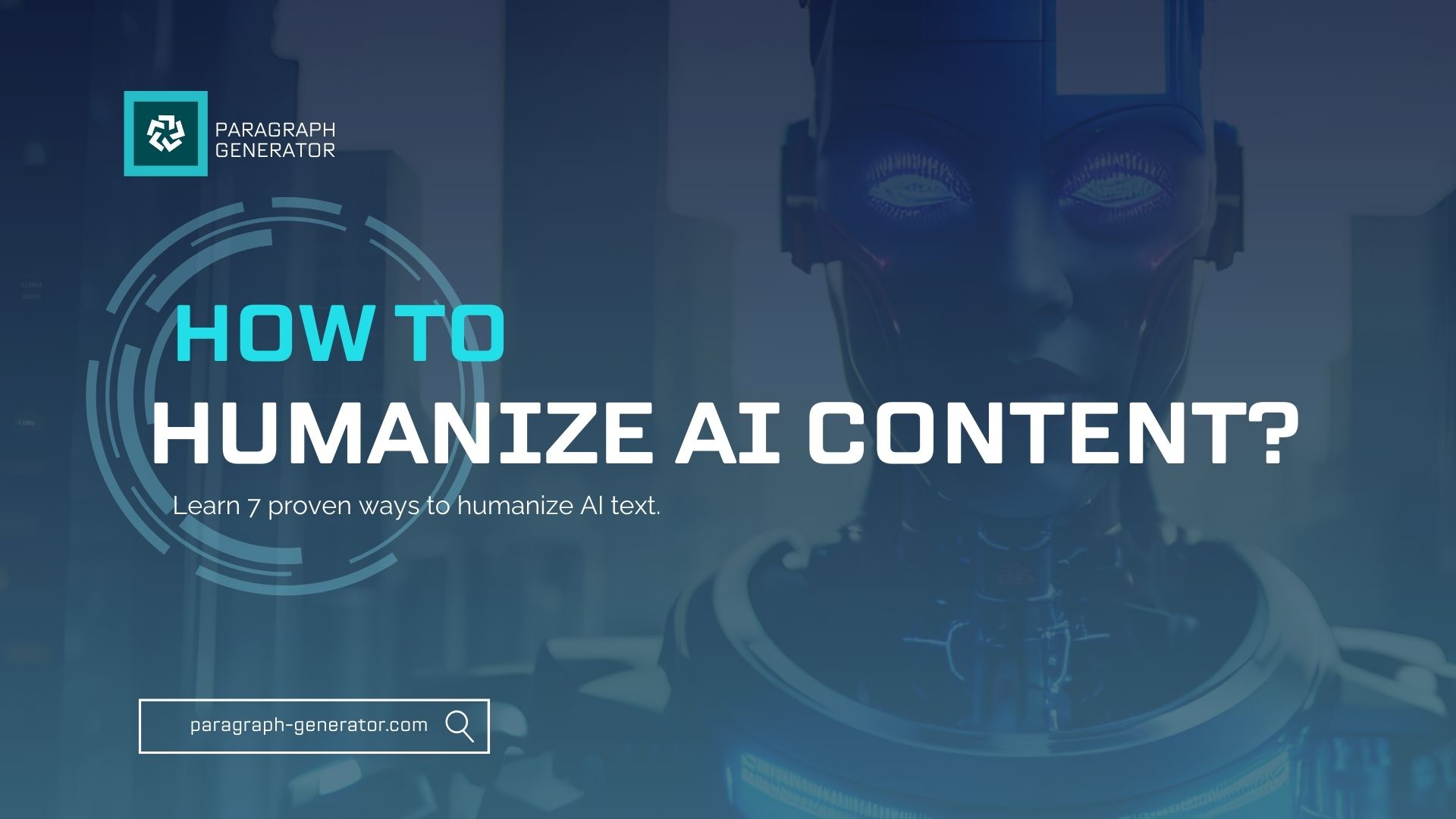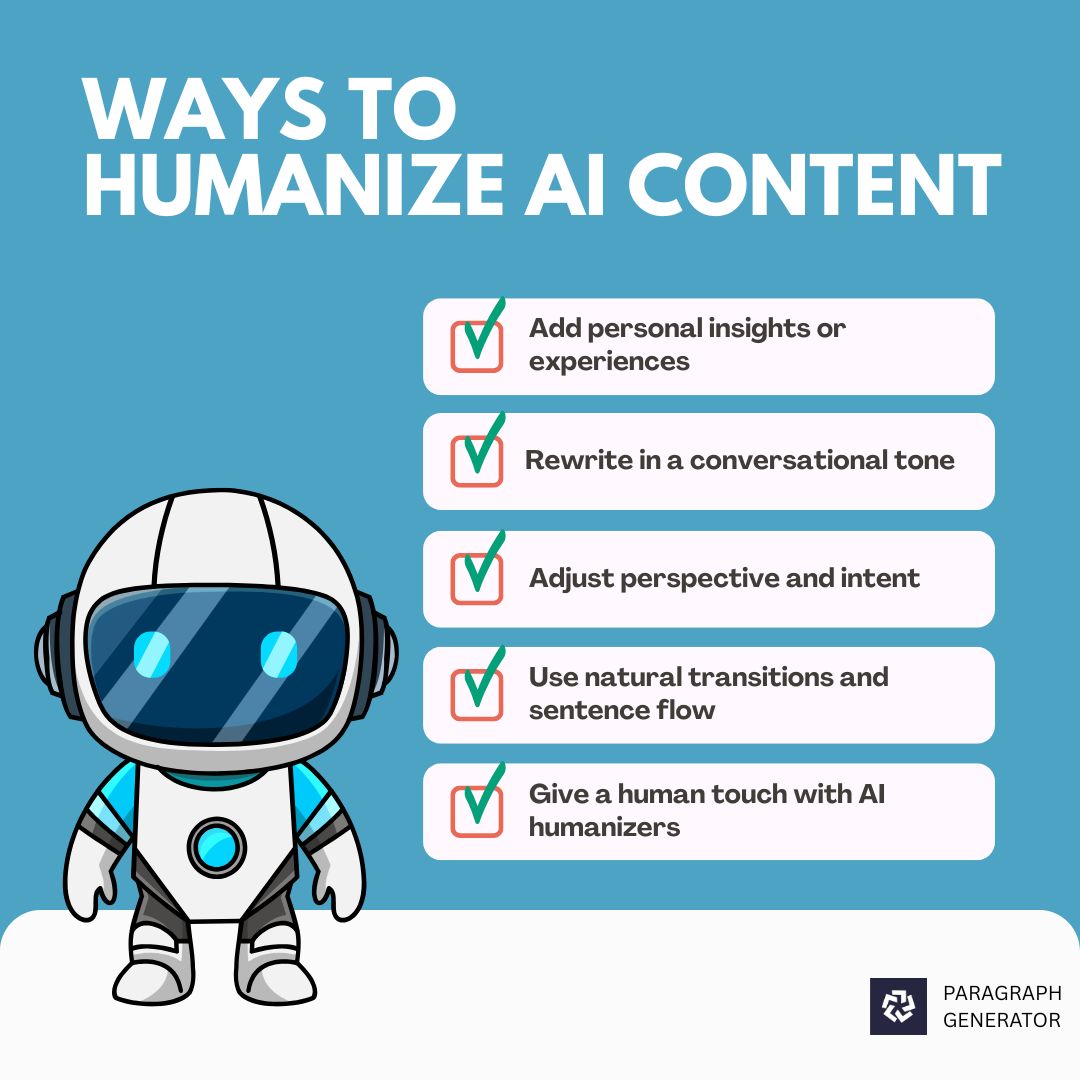How to humanize AI content?
Want to make AI text undetectable? Learn 7 proven ways to humanize AI text. Add emotions and bypass AI detection for a 100% human score.
Almost everybody is using AI tools today for at least one part of their job.
But still, most people prefer consuming human-created content rather than AI-generated, says Ipsos.
And there’s more: in a recent survey, over half of consumers (50.3%) are less likely to engage with AI content.
So we can say AI helps us write faster. But it can’t yet replace what really matters: human voice, emotion, and story.
That’s exactly what this article is about. I’m going to write 7 concrete ways to humanize AI content, with real-life examples you can use.
7 ways to humanize AI content (with real examples)
Before we start, let’s clear one thing up. Humanizing AI content doesn’t mean hiding the fact that you used AI.
It means making the final output feel natural and relatable to readers. When your writing connects like a real conversation, it builds trust and keeps readers engaged.
In fact, human writing brings more traffic per minute.
So, here are 7 simple yet powerful ways to make AI-written content sound more human.
1. Add personal insights or experiences
This is the best way to make AI-generated content feel human-written. Because it contains real-life experiences, stories, and personal insights.
It’s like a mixture of both AI and human-written text.
But as Google does not mind AI content as long as it has EEAT (Experience, Expertise, Authority, and Trustworthiness), you are good to go.
For example:
AI might write: “Reading helps improve vocabulary and comprehension.”
You can rewrite it by saying: “When I started reading 10 minutes before bed, my vocabulary improved. And I also found it easier to unwind after long workdays.”
See the difference? Your story builds like an authentic experience.
2. Rewrite in a conversational tone
A conversational tone instantly makes your content sound more human and engaging. Instead of writing like an essay, write as if you’re talking to your reader.
Use simple words, contractions (like you’re or it’s), and even rhetorical questions to keep the flow natural. Like the following image.
For example:
AI might write: “One should always verify the authenticity of information before sharing it.”
You can humanize it by saying: “Before you hit share, do a quick fact-check. You’ll thank yourself later!”
The second version feels more personal and relatable, which makes it undetectable AI content.
3. Adjust perspective and intent
AI-generated content is often neutral. Because AI lacks emotional highs and lows that real humans have. They do not have an opinion.
So, to humanize ChatGPT content, you need to adjust the intent according to the message or audience.
First, determine what you want your readers to feel. Like excitement, empathy, curiosity, or urgency. Then tailor your tone accordingly.
For example:
AI might write: “The product helps users save time.”
You can humanize it as: “Finish your work in half the time and have hours to relax. That’s what this product offers.”
The second version makes readers feel something. It’s not just information; it’s motivation. That’s what human writing is all about.
4. Use natural transitions and sentence flow
AI writing is often called robotic. That’s because the content feels broken, which means the flow is not quite right.
Humans bring that flow through natural transitions. We don’t write or speak in uniform blocks. We use different types of sentences and connecting phrases to guide our readers from one idea to the next.
For example:
AI version: “AI tools create content fast. They are efficient. But they lack creativity.”
Human version: “AI tools are incredibly fast and efficient, but let’s be honest — they still struggle with creativity.”
The second example feels like a natural conversation. It shows that a real person is behind the words.
5. Include storytelling elements
Storytelling is another powerful way to make AI text undetectable and alive.
We humans naturally connect through stories. In fact, Robert McAfee Brown once said:
Because it evokes emotion and makes your message memorable.
So, instead of adding plain facts, wrap them in experiences. You can start with “I remember when…,” “Imagine this situation…,” or “Let’s say you’re working on…” to draw readers in.
For example:
AI version: “Good writing tools help improve productivity.”
Human version: “When I first started using writing tools, I was amazed by how much faster they write. It feels like having a partner who doesn’t get tired.”
That small story adds relatability. Something that AI often misses.
6. Verify and add real data or research
AI is not always right. Yes, it can even create or manipulate stats on its own to make its content look authentic.
Therefore, it is important to double-check every fact and stat you get from any AI tool.
For example:
AI might write: “Personalised content improves customer engagement by 80%.”
If you look, you will not find it online. The closest stat will be 71 % of consumers expect personalised interactions from brands, according to McKinsey & Company.
7. Give a human touch with AI humanizers
Now this one is the easiest way to humanize AI text. AI tools today are designed to refine your tone, rhythm, and structure of your writing.
They make it sound like something a real person would say.
Like the tool at paragraph-generator.com analyzes your text and rewrites it from scratch. With more natural sentence flow, varied vocabulary, and emotional balance.
This AI humanizer doesn’t just change words. It mimics a human writing style to express your ideas. Hence, it gets a 100% human score.
For example:
AI output: “The product was launched successfully and customers were satisfied with its performance.”
Humanizador version: “The launch went even better than expected—customers loved how smooth and reliable the product felt from day one.”
So, before you publish, run your AI-generated draft through a reliable humanizer. It will polish your text and bypass AI detection.
Conclusion
Readers crave connection, not information. They can get that from AI chatbots now. A writer’s job is to present them differently.
And that comes only from a human touch. By adding personal insights, emotions, natural transitions, and real data, you can turn robotic text into something that truly resonates.
If you want to refine your text even further, tools like humanizador.net can help you humanize your AI drafts while keeping their uniqueness.
So, let every word sound like you. Because authenticity is what readers trust most.


